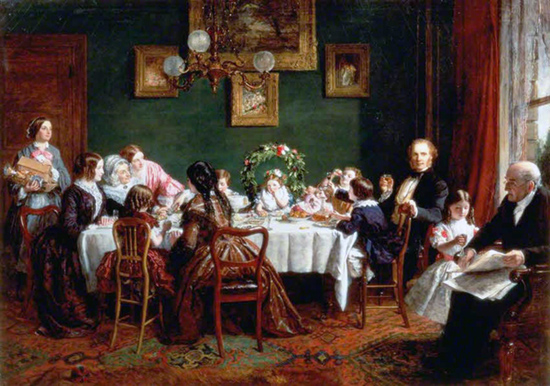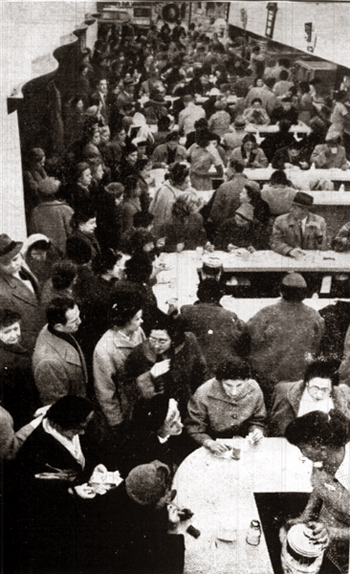Organic Society
 |
 |
 |
 |
 |
 |
 |
Natural & Organic Life vs.
Artificial & Mechanical Existence

William Powell Frith ― 'Many Happy Returns of the Day' 1856.
The furnishings are not luxurious. Solid, decent, comfortable, pleasant to look at, they serve more than sufficiently for human use. A good spacious table around which a large family can sit easily accommodates the healthy and modest delicacies served at a birthday luncheon of a family in the social level somewhere between the small and middle bourgeoisie. The well made chairs with pleasing lines are strong enough to last indefinitely. A large rug, not a luxury item but of a commercial make, gives a certain warmth to the room.
The clothing fits coherently with the ambience: good fabrics, comfortable and with a style that does not lack a certain bourgeois distinction. The maid, though more modest in presentation, is also dressed with decency and comfort. Through the window, protected by sheers and curtains, a pleasant light enters, enough to illumine the whole room, but graduated so as not to hurt the eyes, thus maintaining a calm, temperate clarity in the ambience.
Calmness, temperance, amenity are the dominant notes of the picture. The very upright clothing gives an aspect of purity to this family life, which explains in turn the amenity of their relationship. In a family where the gnawing worm of impurity has entered, souls have neither the health nor freshness to delight in the chaste affections like those of the home. Everyone feels happy and relaxed in this ambience where each one knows he is esteemed, supported and considered as he deserves to be.
We used the expression to be considered intentionally. Notice the situation of the older couple. The family’s warmest affection is turned toward them. Two daughters abounding with respectful affection flank their mother. The young girl is happy and honored to present a drink to her grandfather under the kindhearted and watchful eye of a man of mature age sitting at the table.
To the delight of the children, there is also a place for them at this gathering. Two boys chat with smiling faces; a girl is being lovingly served by her mother. Across from her, another boy, quieter in nature, enjoys his own serenity. And meanwhile the little birthday girl, happy and serious like a queen under her crown of flowers, has just tasted a delicacy, and her gaze – at the same time carefree and attentive - wanders around the room. But even if the group is largely made up of children, they do not dominate the room...
It is a comfortable, healthy, placid and chaste ambience, which merits being compared to the "Buissonnets" of Lisieux (1) if one were to find in the room some religious image and a supernatural note that would transcend, illuminate and give more elevation to this domestic interior so rich in the traditional values of authentic Christian Civilization. In short, this is an ambience that favors the well-being of mind and body, which admirably disposes souls to the practice of a solid, serious, balanced and stable virtue.

Many men wear their hats, as if they were in a train station or a bus. Note, however, their dress: they are all of a level equivalent to the small or middle bourgeoisie. Precisely the level of the family seated at the table above. This is the interior of a fast-food restaurant in a large modern city.
And this is how millions of people take their lunch almost every day of the year – and many also have dinner the same way.
Could it be otherwise? The large agglomeration of people and the resulting concentration of businesses produce a high speed rhythm of life, further accentuated by the dizzying facility to spend money due to the radio, the telegraph and telephone. In the end, everything works to give the modern man shaky conditions of life.
Yes, but at what cost to his health, nerves, equilibrium, virtue and family life? Do we not see in this an expression of dangerous mechanization of modern day life?
- "Buissonets" is how the family of St. Therese of Lisieux used to call the house of their parents.

Catolicismo n. 58, October 1955
Posted October 23, 2013
Organic Society was a theme dear to the late Prof. Plinio Corrêa de Oliveira. He addressed this topic on countless occasions during his life - at times in lectures for the formation of his disciples, at times in meetings with friends who gathered to study the social aspects and history of Christendom, at times just in passing.
Prof. Plinio
Atila S. Guimarães selected excerpts of these lectures and conversations from the transcripts of tapes and his own personal notes. He translated and adapted them into articles for the TIA website. In these texts fidelity to the original ideas and words is kept as much as possible.
______________________
______________________












